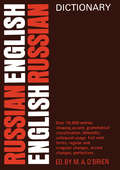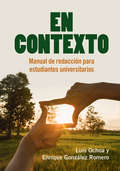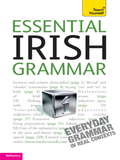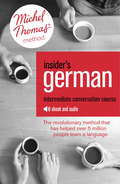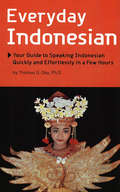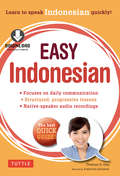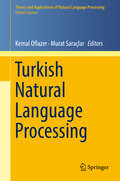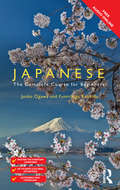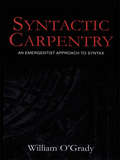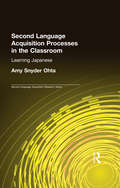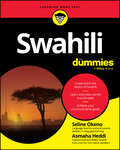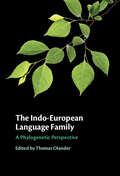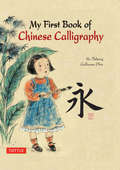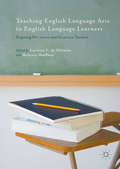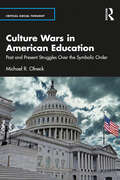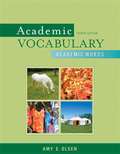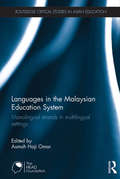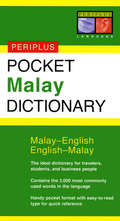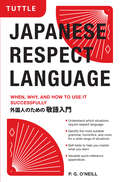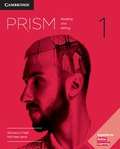- Table View
- List View
New Russian-English Dictionary (Dover Language Guides Russian)
by M. A. O’brienHandiest Russian dictionary in print, with surprising amount of information, including accent changes in declension and conjugation, irregular forms, special treatment of perfectives, etc. Used in scores of colleges. Over 70,000 entries.
En Contexto: Manual de redacción para estudiantes universitarios
by Luis Ochoa Enrique González RomeroWritten entirely in Spanish by instructors with years of experience, this textbook is a comprehensive guide to essay writing in Spanish. It provides advanced students of Spanish with the necessary tools to write fluently and effectively, both developing their reading, writing and critical thinking skills, and teaching them to practically analyse the rules of spelling, punctuation and grammar. It is organised into six chapters, progressing in level and complexity, which take students step-by-step through the writing process. Each chapter contains a number of features such as lists of new vocabulary, assessment checklists, questionnaires, and activities based on writing samples. It also includes an accompanying web resource, which features additional exercises for students, and a lesson plan and downloadable PowerPoint presentations for teachers. By drawing on the principles of grammar, this essential resource will help students become proficient writers, across a range of textual genres.
The Native Languages of South America
by Loretta O'Connor Pieter MuyskenIn South America indigenous languages are extremely diverse. There are over one hundred language families in this region alone. Contributors from around the world explore the history and structure of these languages, combining insights from archaeology and genetics with innovative linguistic analysis. The book aims to uncover regional patterns and potential deeper genealogical relations between the languages. Based on a large-scale database of features from sixty languages, the book analyses major language families such as Tupian and Arawakan, as well as the Quechua/Aymara complex in the Andes, the Isthmo-Colombian region and the Andean foothills. It explores the effects of historical change in different grammatical systems and fills gaps in the World Atlas of Language Structures (WALS) database, where South American languages are underrepresented. An important resource for students and researchers interested in linguistics, anthropology and language evolution.
Essential Irish Grammar: Teach Yourself
by Éamonn Ó'DónaillEssential Irish Grammar will help you get more out of your study of Irish. Essential Irish Grammar is an up-to-date introduction to Irish grammar. You don't need to know a lot about grammar before you start. Everything is explained simply and there are lots of examples to illustrate each point. Unlike more traditional grammars, Essential Irish Grammar is structured so that you can look up language forms according to what you want to say, even if you don't know the grammatical term for them. If you already know some grammar, then you can use the 'reference grammar' section at the back of the book to look up the points you need.The course consists of 20 units illustrating the various uses to which the language can be put, for example, giving instructions or talking about the recent past. The more traditional reference grammar deals with grammatical structures, such as the imperative or the perfect tense. All grammatical terms are explained in the glossary at the back of the book. Each unit contains exercises for you to practise what you have learnt and there is a key at the back of the book for you to check your answers. The new page design in this edition means that the book is even easier to use and the main headings are in English so that you can find your way around the book quickly. This edition contains a 'taking it further' section which will direct you to further sources of real Irish. Essential Irish Grammar will help you to understand and manipulate Irish grammar with confidence because:- you need no prior knowledge of grammatical terminology to use it;- the approach is accessible and supportive;- the examples are clear and in context;- exercises help you practise every point.Now in a brand new edition with new, easy-to-follow page design and interactive on-line features:NOT GOT MUCH TIME?One, five and ten-minute introductions to key principles to get you started.AUTHOR INSIGHTSLots of instant help with common problems and quick tips for success, based on the author's many years of experience.USEFUL VOCABULARYEasy to find and learn, to build a solid foundation for speaking.END-OF-UNIT SUMMARIES AND ONLINE TESTSSummaries and tests to help you keep track of your progress.EXTEND YOUR KNOWLEDGEExtra online articles at: www.teachyourself.com to give you a richer understanding of the culture and history of Irish.
Insider's German Intermediate Conversation Course (Learn German with the Michel Thomas Method): Enhanced Ebook
by Marion O'Dowd Michel ThomasDo you want to be able to express yourself in German with confidence and fluency?Insider's German offers a local perspective on German culture, opinions and language use so that you can speak confidently on today's most important and relevant topics. This intermediate German conversation course, devised for all intermediate-level learners or those following on from Total or Perfect German, will advance your overall fluency, listening comprehension and conversation skills, expand your vocabulary and improve your grammar. Through authentic, lively conversations around engaging topics, and the unique Michel Thomas Method for learning, this course focuses on the colloquial language and conversation strategies used by native German speakers so that you can fit in and communicate more naturally.Michel Thomas, the preeminent language teacher, always said that learners start by mastering basic linguist structures (as in his Total and Perfect courses), which provide the bare walls of the house, but that it was up to us, the learner, to decorate it in our own personal way. Insider's German reflects Michel Thomas's 'Phase 2' courses that he and his team offered at his New York language school, allowing increased vocabulary, improved speaking, comprehension and reading and writing skills - the tools with which to decorate their houses.Insider's German includes:· Twenty authentic conversations around a comprehensive range of subjects that reflect contemporary German culture· Language plus: conversation strategies, pronunciation and intonation to help learners express themselves naturally· Listening and speaking practice to help learners progress to the next level· Cultural insights into the unspoken rules of the language This ebook includes 10 chapters with integrated audio conversations.Why is the Michel Thomas Method so successful?The Michel Thomas Method draws on the principles of instructional psychology. Knowledge is structured and organised for the student so that you assimilate the language easily and don't forget it. The method deconstructs the language into building blocks that are introduced sequentially in such a way that the learner creates his/her response and moves on to ever-more-complex sentences. Michel said: I will dissect everything into small parts and reassemble it in such a way that one will understand everything step by step.He was also very clear about his ground rules: no memorisation, no drills, no homework; relax and leave off the anxiety normally associated with language learning.
Everyday Indonesian
by Thomas G. OeyThis is a travel sized and easy-to-use Indonesian phrasebook, dictionary, and beginning Indonesian language bookThe lessons in this book are prioritized, with more important words and phrases being give first, so that you may profit no matter how deeply into the book you go. By studying the first section only, you acquire a basic "survival" Indonesian, and by mastering the first three sections you should be able to get around quite well on your own. In order to present each lesson clearly as a unit and reinforce learning, Indonesian vocabulary is often repeated. Colloquial Indonesian, which is the most commonly spoken and the most readily understood form of the language is used. By repetition and memorization of the materials, you will quickly gain a grasp of the language's basic elements. Everyday Indonesian includes:Over 2,000 of the most commonly used Indonesian words and phrasesA useful and concise Indonesian dictionaryExtensive notes on grammar and the Indonesian langaugeCultural dos and dont's that will make your visit go smoothlyKnowing a few simple phrases of Indonesian opens up an entirely new and more fulfilling travel experience.
Easy Indonesian: : Learn To Speak Indonesian Quickly
by Thomas G. Oey Katherine DavidsenIndonesia is the hot new Asian destination, a country where lively conversation, good humor and warm human interaction are integral parts of daily life. Easy Indonesian brings the language and culture of Indonesia alive, giving you all the basics you need to start speaking Indonesian immediately. The opening chapters introduce the essentials of pronunciation and sentence construction, with each subsequent chapter moving you forward in gradually building up your knowledge for specific situations and activities, such as making new acquaintances, going shopping, traveling around, and much more. Every chapter contains helpful information on the customs and culture of this warm and friendly country, so that you'll soon be able to talk about everything from the weather to your job and home and family with ease. An extensive glossary at the back and a section on verb and noun forms are included to help you build your vocabulary and understand the different forms that Indonesian words take
Turkish Natural Language Processing (Theory and Applications of Natural Language Processing)
by Kemal Oflazer Murat SaraçlarThis book brings together work on Turkish natural language and speech processing over the last 25 years, covering numerous fundamental tasks ranging from morphological processing and language modeling, to full-fledged deep parsing and machine translation, as well as computational resources developed along the way to enable most of this work. Owing to its complex morphology and free constituent order, Turkish has proved to be a fascinating language for natural language and speech processing research and applications.After an overview of the aspects of Turkish that make it challenging for natural language and speech processing tasks, this book discusses in detail the main tasks and applications of Turkish natural language and speech processing. A compendium of the work on Turkish natural language and speech processing, it is a valuable reference for new researchers considering computational work on Turkish, as well as a one-stop resource for commercial and research institutions planning to develop applications for Turkish. It also serves as a blueprint for similar work on other Turkic languages such as Azeri, Turkmen and Uzbek.
Colloquial Japanese: The Complete Course for Beginners (Colloquial Series)
by Junko Ogawa Fumitsugu EnokidaColloquial Japanese provides a step-by-step course in Japanese as it is written and spoken today. This new edition has been completely rewritten by experienced teachers; it combines an accessible approach with a thorough treatment of the language, equipping learners with the essential skills needed to communicate confidently and effectively in Japanese in a broad range of situations. No prior knowledge of the language is required. Key features include: progressive coverage of speaking, listening, reading and writing skills jargon-free explanations of grammar, with key structures presented through user-friendly diagrams Coverage of the different writing systems of Japanese: hiragana, katakana and kanji an extensive range of focused and stimulating exercises realistic and entertaining dialogues covering a broad variety of scenarios useful vocabulary lists throughout the text additional resources available at the back of the book, including a full answer key, a grammar summary, a verb/adjective list with conjugation aid, bilingual glossaries and English translations of dialogues Balanced, comprehensive and rewarding, Colloquial Japanese will be an indispensable resource both for independent learners and for students taking courses in Japanese. Audio material to accompany the course is available to download free in MP3 format from www.routledge.com/cw/colloquials. Recorded by native speakers, the audio material features the dialogues and texts from the book and will help develop your listening and pronunciation skills. Supplementary exercise sheets for hiragana, katakana and kanji and two additional units can also be found here. These additonal units cover more advanced features of Japanese and incorporate a wide assortment of supporting exercises. By the end of this course, you will be at Level B1 of the Common European Framework for Languages and at the Intermediate-Mid on the ACTFL proficiency scales.
Syntactic Carpentry: An Emergentist Approach to Syntax
by William O'GradySyntactic Carpentry: An Emergentist Approach to Syntax presents a groundbreaking approach to the study of sentence formation. Building on the emergentist thesis that the structure and use of language is shaped by more basic, non-linguistic forces—rather than by an innate Universal Grammar—William O'Grady shows how the defining properties of various core syntactic phenomena (phrase structure, co-reference, control, agreement, contraction, and extraction) follow from the operation of a linear, efficiency-driven processor. This in turn leads to a compelling new view of sentence formation that subsumes syntactic theory into the theory of sentence processing, eliminating grammar in the traditional sense from the study of the language faculty. With this text, O'Grady advances a growing body of literature on emergentist approaches to language, and situates this work in a broader picture that also includes attention to key issues in the study of language acquisition, psycholinguistics, and agrammaticism. This book constitutes essential reading for anyone interested in syntax and its place in the larger enterprise of cognitive science.
Thanking and Politeness in Japanese
by Jun OhashiThis book synthesizes previous work on thanking, politeness and Japanese pragmatics and crystallises the theoretical underpinnings of thanking, how it is realized linguistically and the social meaning and significance of this aspect of Japanese communication.
Second Language Acquisition Processes in the Classroom: Learning Japanese (Second Language Acquisition Research Series)
by Amy Snyder OhtaThis book is the first study to examine how interactional style develops within the walls of a foreign language classroom in the first two years of language study. Results show learners to be highly sensitive to pragmatic information and that learners can move toward an appropriate interactional style through classroom interactive experience. The book shows how learners are most often sources who offer assistance and correction, with errors serving most often to stimulate further thinking about what form is correct. Analysis shows learners to be active in seeking corrective information in the classroom setting, not only from peer partners but also from the teacher. They are active in noticing how the teacher's utterances--even when addressed to others--contrast with their own, and utilize corrective feedback intended for other students. In addition, the results show that teacher-initiated corrective feedback addressed to individual learners is only one source of corrective feedback. Learners are shown to be active in both teacher-fronted and peer interactive settings. In newer L2 teaching methodologies which focus on the use of peer interactive tasks, the teacher's role has been de-emphasized. This book, however, shows how important the teacher's role is. The final chapter examines how the teacher can act to maximize the benefits of peer interactive tasks through how they design tasks and present them to the class. First, the chapter looks at how learners use English--their L1--in the classroom, concluding that how teachers present activities to the class has an impact on the amount of L1 used by students during peer interaction. Following up on this finding, the chapter works to address questions that teachers face in lesson planning and teaching. It presents a useful list of questions teachers can ask when designing peer interactive tasks in order to maximize the effectiveness of a wide variety of language learning tasks.
The Social Life of the Japanese Language
by Okamoto, Shigeko and Shibamoto-Smith, Janet S. Shigeko Okamoto Shibamoto-Smith, Janet S.Why are different varieties of the Japanese language used differently in social interaction, and how are they perceived? How do honorifics operate to express diverse affective stances, such as politeness? Why have issues of gendered speech been so central in public discourse, and how are they reflected and refracted in language use as social practice? This book examines Japanese sociolinguistic phenomena from a fascinating new perspective, focusing on the historical construction of language norms and its relationship to actual language use in contemporary Japan. This socio-historically sensitive account stresses the different choices which have shaped Japanese and Western sociolinguistics and how varieties of Japanese, honorifics and politeness, and gendered language have emerged in response to the socio-political landscape in which a modernizing Japan found itself.
Swahili For Dummies
by Seline Okeno Asmaha HeddiLearn the official language of Kenya and Tanzania Swahili For Dummies will teach you the basics of Swahili, so you can start conversing in Africa’s language of commerce. This book introduces you to the foundations of Swahili grammar and enables you to engage in basic conversations. With the simplified Dummies learning process, you’ll quickly get a grasp on the language, without complex terms and confusing explanations. You’ll also move through the book at a comfortable pace, so you’ll be familiar with what you’ve learned before moving on to more complex stuff. Focus on communication and interaction in everyday situations, so you can actually use the language you’re studying—right away. Understand the basics of Swahili Learn everyday words and phrases Gain the confidence to engage in conversations in Swahili Communicate while traveling and talk to Swahili-speaking family members Swahili For Dummies is for readers of all ages who want to learn the basics of Swahili in a no-stress, beginner-friendly way. Swahili teachers will also love sharing this practical approach with their students.
The Indo-European Language Family: A Phylogenetic Perspective
by Thomas OlanderModern languages like English, Spanish, Russian and Hindi as well as ancient languages like Greek, Latin and Sanskrit all belong to the Indo-European language family, which means that they all descend from a common ancestor. But how, more precisely, are the Indo-European languages related to each other? This book brings together pioneering research from a team of international scholars to address this fundamental question. It provides an introduction to linguistic subgrouping as well as offering comprehensive, systematic and up-to-date analyses of the ten main branches of the Indo-European language family: Anatolian, Tocharian, Italic, Celtic, Germanic, Greek, Armenian, Albanian, Indo-Iranian and Balto-Slavic. By highlighting that these branches are saliently different from each other, yet at the same time display striking similarities, the book demonstrates the early diversification of the Indo-European language family, spoken today by half the world's population. This title is also available as open access on Cambridge Core.
My First Book of Chinese Calligraphy
by Guillaume Olive Zhihong HeMy First Book of Chinese Calligraphy is a fun and engaging introduction to one of China's most popular arts and crafts for kids. <P><P>Calligraphy-the art of producing decorative handwriting or lettering with a pen or brush-has been around for thousands of years. In this book, readers will follow along with Mimi who takes her first steps towards learning this magical art. Dive in, and explore:The Evolution of Chinese Writing-how Chinese characters first began, thousands of years ago, and how they have evolvedThe Order of the Strokes-learn how to write the strokes in the correct orderThe Four Treasures of Calligraphy- the four essential tools to get startedMovements and Position-how to master your mind's focus, your breathing and even how to moveThe Five Styles of Calligraphy-Zhuan Shu (seal), Li Shu (clerical), Kai Shu (regular), Cao Shu (cursive), and Xing Shu (running)The Eight Strokes- how to draw the 8 strokes; with them, you can write anythingWriting a Character in Calligraphy-create an entire character in calligraphyThe included interactive CD-ROM enables learners to play creative games to see, hear and try Chinese writing; listen to the pronunciation of the Chinese characters; observe calligraphers in action and print the characters to create practice pages.
Teaching English Language Arts to English Language Learners
by Luciana C. Oliveira Melanie ShoffnerThis book focuses on the ways in which English language arts (ELA) pre-service and in-service teachers have developed - or may develop - instructional effectiveness for working with English language learners (ELL) in the secondary English classroom. Chapter topics are grounded in both research and practice, addressing a range of timely topics including the current state of ELL education in the ELA classroom, and approaches to leveraging the talents and strengths of bilingual students in heterogeneous classrooms. Chapters also offer advice on best practices in teaching ELA to multilingual students and ways to infuse the secondary English teacher preparation curriculum with ELL pedagogy. Comprehensive in scope and content and examining topics relevant to all teachers of ELLs, teacher educators and researchers, this book appeals to an audience beyond ELA teachers and teacher educators.
Culture Wars in American Education: Past and Present Struggles Over the Symbolic Order (Critical Social Thought)
by Michael R. OlneckCulture Wars in American Education: Past and Present Struggles Over the Symbolic Order radically questions norms and values held within US Education and analyses why and how culture wars in American education are intense, consequential, and recurrent.Applying the concept of “symbolic order,” this volume elaborates ways in which symbolic representations are used to draw boundaries, allocate status, and legitimate the exercise of authority and power within American schooling. In particular, the book illustrates the “terms of inclusion” by which full membership in the national community is defined, limited, and contested. It suggests that repetitive patterns in the symbolic order, for example, the persistence of the representation of an individualistic basis of American society and polity, constrain the reach of progressive change. The book examines the World War I era Americanization movement, the World War II era Intercultural Education movement, the late-twentieth-century Multicultural Education movement, continuing right-wing assaults on Ethnic Studies and Critical Race Theory in the first decades of the twenty-first century, and historical and contemporary conflicts over the incorporation of languages other than Standard English into approved instructional approaches.In the context of continuing culture wars in the United States and across the globe, this book will be of interest to graduate students and scholars in critical studies of education, history of education, sociology of education, curriculum theory, Multicultural Education, and comparative education, as well as to educators enmeshed in contemporary tensions and conflicts.
Academic Vocabulary, Academic Words (4th edition)
by Amy E. OlsenAcademic Vocabulary presents vocabulary building with a visually stimulating, full-color design to pique students' interest and make the process fun. This attractive, highly-interactive workbook improves academic word knowledge through academic readings and interactive exercises. Repetition of the words and getting the students to see the words used in multiple contexts improves memorization.
Languages in the Malaysian Education System: Monolingual strands in multilingual settings (Routledge Critical Studies in Asian Education)
by Asmah Haji OmarThis book provides an overview of language education in Malaysia, covering topics such as the evolution of the education system from pre-independence days to the present time, to the typology of schools, and the public philosophy behind every policy made in the teaching of languages. The book consists of chapters devoted to the teaching of languages that form separate strands but are at the same time connected to each other within the education system. These chapters discuss: Implementing the national language policy in education institutions English in language education policies and planning in Malaysia Chinese and Tamil language education in Malaysia Teaching of indigenous Malaysian languages The role of translation in education in Malaysia It also discusses the development of language which enables the national language, Malay, to fulfil its role as the main medium of education up to the tertiary level. This book will be of interest to researchers studying language planning, teacher education and the sociology of education, particularly, within the Malaysian context.
Pocket Malay Dictionary
by Zuraidah OmarThis is a pocket sized Malay DictionaryIntended for use by tourists, students, and business people traveling to Malaysia Pocket Malay Dictionary is an essential tool for communicating in Malay. It features all the essential Malay vocabulary appropriate for beginning to intermediate students. It's handy pocket format and easy-to read type will make any future trip to Malaysia much easier. In addition to being an excellent English to Malay dictionary and Malay to English dictionary Pocket Malay Dictionary contains important notes on the Malay language, Malay grammar and Malay pronunciation. All Malay words are written in English and Malay script (Rumi) so that in the case of difficulties the book can simply be shown to the person the user is trying to communicate with.This dictionary contains:The 3,000 most commonly used words in the Malay languageEnglish and Romanized Malay (Rumi)An introduction to and history of the Malay languageInformation on Malay grammarA guide to pronouncing Malay correctlyOther books from this bestselling series you might enjoy are: Pocket Vietnamese Dictionary, Pocket Cambodian Dictionary, Pocket Thai Dictionary, Pocket Indonesian Dictionary, Pocket Mandarin Chinese Dictionary, and Pocket Cantonese Dictionary.
Pocket Malay Dictionary
by Zuraidah OmarThis is a pocket sized Malay DictionaryIntended for use by tourists, students, and business people traveling to Malaysia Pocket Malay Dictionary is an essential tool for communicating in Malay. It features all the essential Malay vocabulary appropriate for beginning to intermediate students. It's handy pocket format and easy-to read type will make any future trip to Malaysia much easier. In addition to being an excellent English to Malay dictionary and Malay to English dictionary Pocket Malay Dictionary contains important notes on the Malay language, Malay grammar and Malay pronunciation. All Malay words are written in English and Malay script (Rumi) so that in the case of difficulties the book can simply be shown to the person the user is trying to communicate with.This dictionary contains:The 3,000 most commonly used words in the Malay languageEnglish and Romanized Malay (Rumi)An introduction to and history of the Malay languageInformation on Malay grammarA guide to pronouncing Malay correctlyOther books from this bestselling series you might enjoy are: Pocket Vietnamese Dictionary, Pocket Cambodian Dictionary, Pocket Thai Dictionary, Pocket Indonesian Dictionary, Pocket Mandarin Chinese Dictionary, and Pocket Cantonese Dictionary.
Pocket Malay Dictionary
by Zuraidah OmarThis is a pocket sized Malay DictionaryIntended for use by tourists, students, and business people traveling to Malaysia Pocket Malay Dictionary is an essential tool for communicating in Malay. It features all the essential Malay vocabulary appropriate for beginning to intermediate students. It's handy pocket format and easy-to read type will make any future trip to Malaysia much easier. In addition to being an excellent English to Malay dictionary and Malay to English dictionary Pocket Malay Dictionary contains important notes on the Malay language, Malay grammar and Malay pronunciation. All Malay words are written in English and Malay script (Rumi) so that in the case of difficulties the book can simply be shown to the person the user is trying to communicate with.This dictionary contains:The 3,000 most commonly used words in the Malay languageEnglish and Romanized Malay (Rumi)An introduction to and history of the Malay languageInformation on Malay grammarA guide to pronouncing Malay correctlyOther books from this bestselling series you might enjoy are: Pocket Vietnamese Dictionary, Pocket Cambodian Dictionary, Pocket Thai Dictionary, Pocket Indonesian Dictionary, Pocket Mandarin Chinese Dictionary, and Pocket Cantonese Dictionary.
Japanese Respect Language: When, Why, and How to use it Successfully
by P. G. O'NeillRespect language—the special style of polite spoken or written Japanese—is involved almost every exchange of Japanese between one person and another, including the simplest phrases of greeting.<P><P> An understanding of its forms is therefore essential to any serious student of the Japanese language. This programmed course is carefully designed to teach the basic and correct forms which the learner should master for his or her own use, by first looking at the various typical situations to see when respect should and should not be shown in Japanese, and then going on to see how respect is expressed in special forms of speech. In this way the learner is shown how to identify the type of respect for used, the person to whom respect is being shown, and the equivalent form in colloquial language. The insights into both Japanese culture and language will help any student or businessperson traveling to Japan or speaking Japanese on a regular basis.
Prism: Level 1 Student's Book With Online Workbook Reading And Writing (Prism)
by Richard O'Neill Michele Lewis Wendy Asplin Carolyn FloresPrism Level 1 Student's Book Reading and Writing 9
